It’s Meyer lemon season and I’m going nuts. (Meyer lemon curd, anyone?) Regular readers probably already know how much I love salt-cured lemons. They are an essential condiment around my house, worked into salad dressings, braises, rice pilaf, fresh salsa and more.
Last year, I ran out of salted Meyer lemons in July, with months and months to go before Meyer lemons would come around again. Arg! So this year I made a big batch and discovered a way to streamline the prep for this already very easy fermentation project.
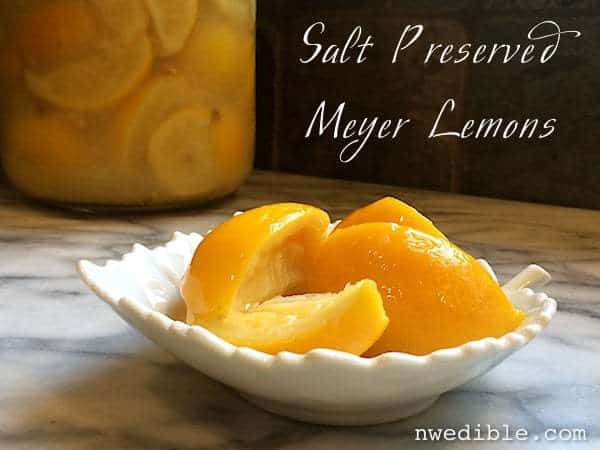
Salt Preserved Meyer Lemons Step-by-Step
You need two things for Salt Preserved Meyer Lemons – salt, and Meyer lemons. I know, it’s one of those things like “Gin & Tonic” where the title basically is the recipe.
A Note about Lemons
Meyer lemons are still a specialty item, and can be tricky to get hold of. You can substitute regular (Lisbon or similar) lemons for this recipe if you prefer.
Please consider going to the extra effort of procuring organic lemons for this recipe. In the finished product, you eat the peel of the lemon. Conventionally grown lemons will likely have various pesticides, fungicides and waxes on the peel. If you must use non-organic lemons, please wash very well with soap (rinse well too) before using them for this preserve.
A Note About Salt
I use Diamond Crystal Kosher Salt, which is typically preferred by professional chefs because it is very easy to measure by feel. The crystals of Diamond Crystal are very fluffy, so a given volume of salt weighs less and contains less sodium as compared to Morton’s Kosher Salt, table salt or fine sea salt. It seems weird, but a tablespoon of Diamond Crystal Kosher salt is just less salty than a tablespoon of fine sea salt.
This is important because I’m not providing exact measurement in this recipe, and when you look at the pictures you will see me using a fair amount of salt. Just keep in mind that if you are using sea salt or another brand of Kosher salt, you may want to use less salt than what I show here.
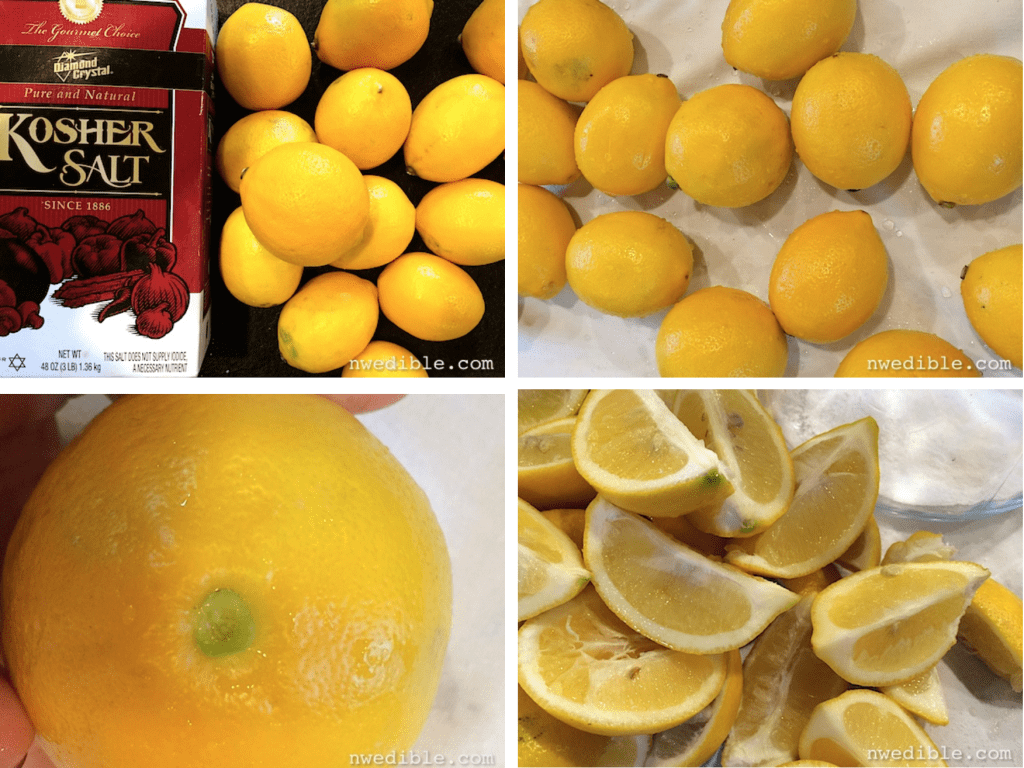
First things, first: get your lemons and your salt. Wash your lemons and dry well. Pick off any stem that’s on the lemons.
Cutting The Lemons:
All salt-preserved lemon recipes direct you to cut your Meyer lemon open like a flower, quartering it but leaving the end attached, so that it opens up like a Bloomin’ Onion. Then you stuff the inside of each lemon flower with salt and close the lemon back up. This is the most tedious and time consuming part of making salt cured lemons. Half the salt falls out while you try to wedge your lemon into a jar.
It occurred to me that I could make salt-preserved Meyer lemons far more simply by just quartering the lemons, tossing them with salt, and pressing them, much like I do to make sauerkraut. When I use salt-preserved lemons, after all, I tend to use them a wedge at a time, so there is no practical advantage for me to having a whole lemon in a jar.
But every recipe includes this step about cutting the lemon and stuffing it with salt in this particular fussy way. So I did some research. There is, so far as I could tell, absolutely no reason why the lemons are cut like a Bloomin’ Onion except tradition. There is no food safety or quality reason. It’s just how people do it.
Not even the otherwise fantastic America’s Test Kitchen DIY Cookbook questioned this step, much to my disappointment. One recipe offered the explanation that keeping the lemons whole made them easier to put into mason jars. Well, that’s just silly. Fitting smaller pieces of things into jars is easier than fitting big hunks of things.
So emboldened, I proceeded with my simplified, streamlined salt-cured Meyer lemon method.
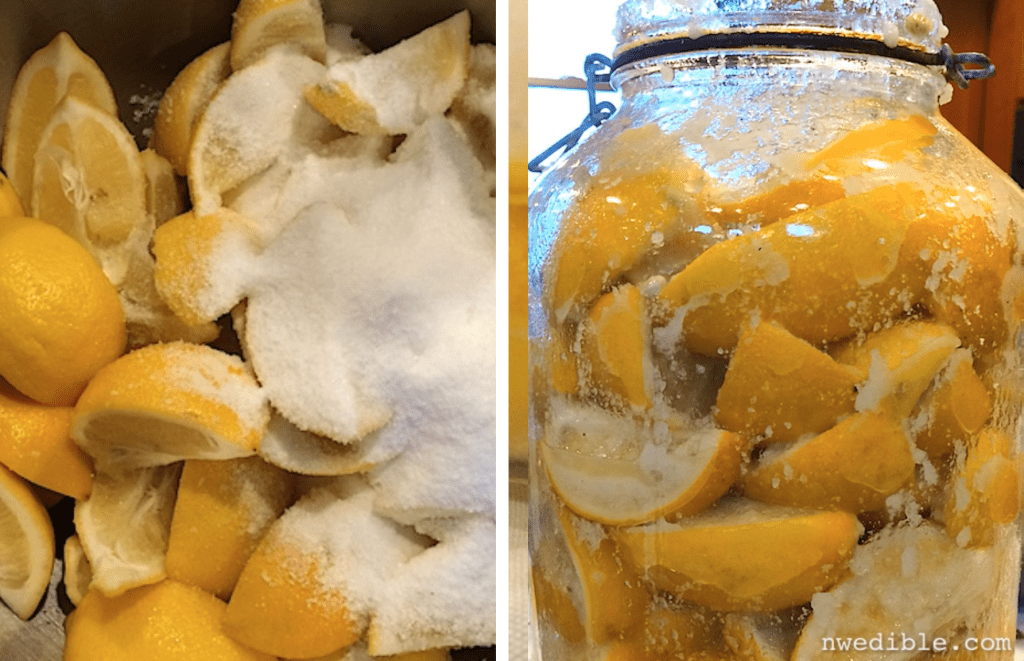
Cut three-quarters of your lemons into quarters, lengthwise. Sorry that sentence is so awkward, I can’t figure anyway around it. In other words, if you are starting with eight lemons, cut six of them into quarters. Reserve the other lemons for juice.
Toss the lemon quarters with salt. I used about 2 tablespoons of Diamond Crystal Kosher Salt (see note on salt, above) for each Meyer lemon I quartered. You want enough salt so that the lemon quarters are all uniformly coated in salt.
Pack the salted lemon quarters into a spotlessly clean jar. Ideally, use a jar that will just hold the lemon wedges. Let the jar sit, covered, at room temperature for about an hour so that the salt can draw some of the juice from the lemons.
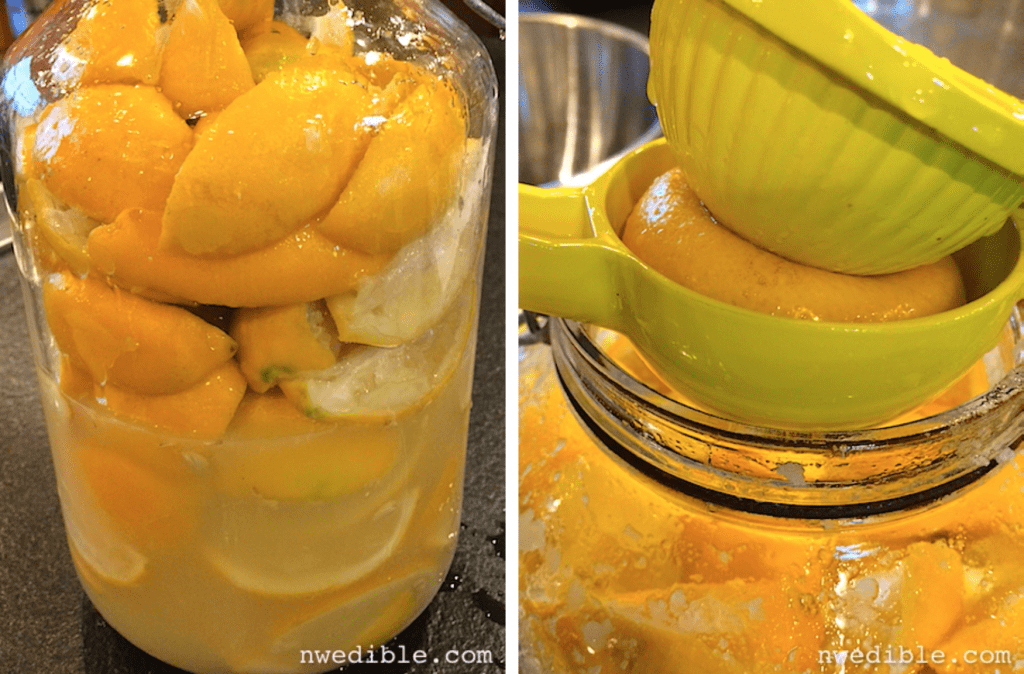
After some juice is released, pack the lemons into the jar by pressing. You can use a spoon or your very clean fist, if the jar opening is large enough. The jar should fill half-way or more with lemon juice.
Juice the lemons you reserved, and add the extra juice to the jar. This should bring the level of the juice near the top of the jar.
Seal the jar and let sit at cool room temperature for four to seven days, giving it a good shake every day. After four days, the lemon rind should begin to take on a glossy translucency. When the rind looks translucent all the way through, or after one week (whichever comes first) transfer the salt-cured Meyer lemons to the refrigerator. Let cure for another week in the fridge.
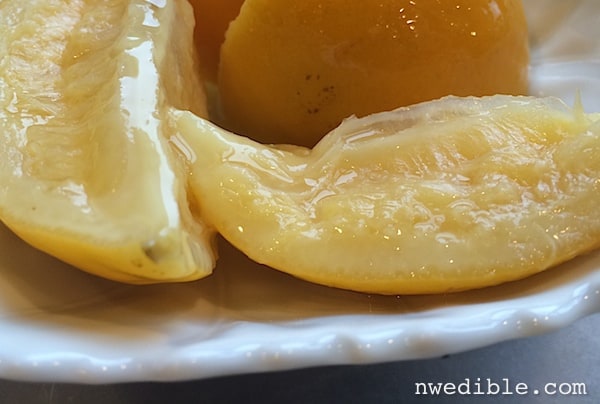
After a week in the fridge, the lemons can be used, but they will continue to mellow and the flavor will improve with longer aging. They will keep in the refrigerator for months and months.
To Use
The typical recommendation it to throw away the fruit – to only use the peel – and to rinse the peel well to remove the salt. I must just be a salted lemon rebel, because I use both the pulp and the peel, and I rarely rinse my salt-cured lemons. I prefer to adjust the salt elsewhere in a recipe. In fact, I love the salty lemony brine that comes along with these lemons so much, I add it to soups and salad dressings instead of using salt.
If you are looking for specific recipe ideas to use your salt preserved Meyer lemons, check out my recipe for Lamb Blade Chops with Apricot Halves and Salt Preserved Lemon.
Related Stuff…
(These are affiliate links. Purchases made through these links cost you nothing extra but may one day allow me to figure out how to successfully grow Meyer lemons in Seattle. Full financial disclosure here. Thank you for your support, guys!)
The best salt (but go buy it locally because, seriously, it should cost about $3 a box): Diamond Crystal Kosher Salt.
I love these big glass jars and use them for many of my ferments: Bormioli Rocco Fido Italian 4 Liter Glass Canning Jar.
This is one of my favorite cookbooks of all time: All About Braising: The Art of Uncomplicated Cooking. It’s incredibly well written and well tested – every recipe just works. There’s a recipe in this book called Moroccan Chicken with Green Olives & Preserved Lemons that is incredible, and inspired me make salt preserved lemons for the first time nearly ten years ago.
Do you love preserved lemons as much as I do? How do you use them?
20
Love the simplified version of the recipe. I totally agree that it is much easier to stuff quartered lemons into a jar than whole ones. Also, I’ve been meaning to congratulate you on getting High Mowing Seeds as your sponsor. Wonderful.
I’ve never had salted lemons, but yours was the second recipe I’ve read in the last 24 hours that recommended Diamond kosher salt specifically and noting you’d need to adjust for Morton’s (which is what I have).
Great post! I tried to make salt preserved lemons last year, and it was an unmitigated disaster! I intend to try it again using your technique and directions. I enjoy your posts and your point of view. Keep up the good work!
I came to the same conclusion a year ago when i was making preserved lemons, we have gone through a jar about the size of the 1 you used and no 1 has got sick so I can confirm its perfectly safe to just quater them.
I have always quarter them too because I like to use smaller canning jars. I also go one step further…. I do the “bartenders cut” where after I quarter them, I cut off the center “stem/membrane” and remove the seeds. Love Meyer lemons and preserved lemons in general and I also use the pulp as well as rind. I think if you use the rind only, you might want to go with regular lemons because the rinds are thicker. Has anyone tried to do salt preserved grapefruit? Just wondering how that would be… I have tried with limes and it was awful… The lovely green color turns an ugly gray.
I did limes, and blood oranges but to be honest i havent tried either. Did the limes taste bad or just look ugly? I just havent found a recipe that I thought either would be good in but I often do that with experimental preservation projects it usually takes me a while to find the right use for them but often once I do i find they give me a new way to look at how I cook. For instance I preserved citrus in sugar instead of salt, I did lemons, limes and oranges thinking I would mostly use them for candied peals but the liquid that the process created ended up a very great house made sweet and sour mix that I now use in a lot of mixed drinks. Sweet and sour with tonic makes a great mocktail!
The limes looked so darn ugly that I just tossed them out. I have found recipes for preserved lemons that called for some sugar added to the salt and also even some olive oil but I don’t think I would like the olive oil or any oil in it but I am going to try adding some sugar to the salt in the next batch. I only do small pint size batches. The sweet and sour aspect of the sugar preserved ones sound interesting….. sometimes even just sprinkle salt on fresh thin slices of lime or lemon and eat them like fruit and they are absolutely wonderful if you broil or grill them.
If the oil doesn’t bother you later when you use the lemons, it does act as a good air seal. But you really don’t need it.
I’ve done limes twice – first time with the green ones you see at the store, and the second time with properly ripe lime, which actually end up a pale yellow when they are fully ripe. They both tasted good, but the green ones were definitely less attractive.
I’m also curious about grapefruit, being that I now live where they are local, abundant and delicious, and I also because I love a good Salty Dog. I wonder how else I would use salted grapefruit? Anyone tried this?
Haha! I just this very week came to the same conclusion you did about the “cut it like a blooming onion” direction in these recipes. “WHY?” I thought to myself. “I just pull them apart when I use them anyway!” So I was very happy to see validation for my rebelliousness here this morning, thank you!
AND — you go girl, with all the posts recently! I am a new-ish gardener in Seattle, discovered your blog about a year ago, and have been eagerly devouring it since. I so applaud you for going “all in” and pursuing sponsorships, etc. I am going to order from High Mowing this year to help support you!
This is how I make mine too. I saw a recipe that actually had them diced (!!) before the salt curing, and I might try that with a small jar this year and see how it goes. It would be super easy to stick a spoon in the jar and just get a scoopful.
Only one thing I’d add – which is kind of a caution (learned from experience). It isn’t unusual for the “brew” to really press against the lid. This isn’t a problem, but if you are using standard canning/mason jars, it will corrode the rings (rather quickly). As a result, I’ve found Preserved Lemons to best be preserved in a Weck’s type jar or similar that doesn’t use a metal ring.
Why have I never heard of salt preserved lemons? My mouth is watering. I MUST try this.
Alright you have me convinced – salt preserved lemons for my weekend project!
Go fig! I made these around this time of year last year and they were a trip to taste and experience. However, I used plain but very special lemons a friend gave me off her tree. They are tart but great in couscous. Thanks for a more in-depth tutorial!
Mouthwatering, yes. Do you trouble with the seeds?
I have a Moroccan cookbook but simply never tried anything that calls for salt preserved lemon. I’m quite “laid back” (it reads “lazy”) and didn’t want the trouble of preserving lemons first (takes time, which means by the time the lemon is ready to be used, I’ll be more likely not interested in the recipe anymore). I guess it’s time to give it a try. Nothing is better than in-season produce. 🙂
By the way, although I rarely shop online, I’ll remember to go to Amazon through your blog next time, for I usually use either MountainRoseHerbs or Amazon. Ever since I found your blog, I had this nagging (guilty) feeling of not being able to “tip you in the jar.” Now I know how I can pay you back within my means for all the goodness you share with us. 😀
Thank you!
MJ from freagin’ freezing Michigan
That was just a joke about not being able to grow Meyer lemons in Seattle right? Even in a greenhouse?
(Please say it isn’t so…)
I’m curious about that too. A few years ago, i worked with Ukrainian supervisor who told me that he had lemon trees back in Ukraine. Isn’t Seattle in a warmer zone? Well, he was a super green-thumb and has a beautiful garden here in Michigan. But anyhow, I wonder how far north the lemon tree can grow. Maybe Seattle doesn’t have enough sunny days?
it’s quite easy to grow Meyer lemons (and other citrus) in Seattle or anywhere else in the US. In colder zones one must take the pots inside through the winter.
I Love, love preserved lemons! However, We adore Meyers above all other fruit, except perhaps blackberries.
We have not yet been able to procure an amount of Meyers so large that we can give up a single rind for anything but our SO loved limoncello! Meyers make the best curd & that is great, as we have copious amounts of rindless lemons this time of year! (we live in Colorado)
I hate to buy a product that we can make, however, & I am sure will taste even more wonderful. Preserved lemons are high on the ingredient list for summer cooking.
Off in the snow in search of any more we can locate. I hope when I do, our truck won’t auto-pilot to the liquor store for more vodka!
Thank you for such delicious & inspiring pictures, too! I’m hooked ~
I have never had preserved lemons, but it seems pretty damn easy and I bet the flavor is amazing! Looking forward to more fermentation experiments!
I did preserved lemons last year for the fist time, fun and easy. But beware, talk about adding salt to a wound, then pouring lemon juice on it! With all that bloomin onion stuffing bit, my cuticles were a mess, my poor hands!
Thanks for dissecting this one for us. Besides using the liquid for soups and stews, can you wonderful people tell me how you use these in vegetarian or vegan dishes? Like Erica’s recipe suggestion above, I can only remember seeing salt preserved lemons in meat or fish recipes. Any other ideas? what about in desserts? I’d love to try this out, but only if I can figure out how to use them!
I would steer clear of trying to work these into desserts. But they are quite veg-friendly. A few ideas: Mix into any kind of grain pilaf, add to white bean purees or hummus-type things, make into a vinaigrette for steamed veg of all kinds, chop and mix with a walnut-mushroom puree to punch up vegan pate (btw, the walnut mushroom pate recipe in Veganomicon is fantastic – and this from someone who eats bacon), chop and mix into a creamy lemon dressing for a spinach salad with pomegranate seeds and almonds, chop and use to coat cauliflower before high-heat roasting, mix with tahini to make a sesame-lemon spread for veggie flatbread wraps, season soups of all kinds with them, chop and mix with bread crumbs and parsley and garlic and (optional parm), then top roasted portobella mushrooms with the mix and broil until crunchy ….the uses are almost limitless. Salt cured lemons: not just for carnivores. 😀
Interesting, thanks. It seems as though you never (or hardly ever?) really eat them, but rather chop/smash/puree them purely for the flavors they add- more like a seasoning.
Also, unrelated, it used to be when I commented, I could click a little box to notify me of replies and I’ve noticed that’s gone now (or else it’s so well hidden I can’t find it). I’d love that feature to make it’s way back!
I just made the most awesome roasted potatoes with preserved lemons. Cut small or fingerling potatoes in half and toss with olive oil, salt, pepper and rosemary. Roast at 450 for about 30 minutes, flipping them over halfway through. When done, toss with very thinly sliced pieces of the preserved lemon peel. OMG, it was wonderful!!! You can also toss preserved lemon slices or diced pieces into salad dressing, grains, broccoli, etc. etc.
I just put 3 pints up to start fermenting! In addition to adding delicious flavor to meat-based stews, etc., I love preserved lemons in lentil salad or in eggplant dishes.
Hi! I saw this recipe and it looks amazing. One question- when it says to seal the jar and let it sit on the counter- does that mean seal it as if you are canning it? Or just screw on the top tightly? Thanks!
Just screw the lid on. It doesn’t even have to be that tight, really.
I make and use preserved lemons and can recommend them as a tasty and wonderful ingredient in bloody mary tomato cocktails – but that assumes you have a low salt tomato juice base.
Finally stuffed a half gallon Mason jar with lemon quarters today: I can’t wait to try these! I had to use regular lemons, as that’s what Azure Standard had in quantity for organic lemons, and that’s my most reasonable source.
I wish the Portland Costco had organic lemons. Back in Madison, WI, the Costco there carried a really good bottled organic lemon juice (in wine bottles) from the Amalfi Coast. Not useful for making fermented lemon, but good enough to make lemonade. Not at the Portland Costco, more’s the pity. Until I moved I though all the Costco’s carried pretty much the same things. Not true!
It Just occurred to me I have made these the last two winters and at no time have I ever refrigerated them. I am assuming that this method was developed in north Africa or the middle east in order to preserve lemons before refrigeration existed but I was wondering if they are better if you do refrigerate them before you use them?
I’ve been making them for 25 or so years, and I’ve never refrigerated them either. Mine also last more than 6 months. One jar that got pushed to the back of a dark cupboard (in the coolest room in the house) was 3 years old when I found it and the fruit was still perfect. I live in a fairly warm area of Australia with no AC, so salted lemons (or limes) are pretty long lasting.
Came upon salting wedges when I had a container full after catering a function and couldn’t find any spare fridge space. Works well and I too can’t figure out why we are directed to discard the flesh when it is such a delicious addition to so many dishes. Glad to see I’m not the only barbarian
I’ve been making these for a few years and love them but I use the traditional Moroccan technique…same brand Kosher salt…use quarter cut into lemon down stem to blossom end, but not all the way through, pack each with salt and stuff in jar, when jar is full, just pour 1/2 inch of good quality olive oil on top and put the lid on. As the salt pulls the juice out of the lemons the oil seal floats on top and keeps air from causing any damage. In the middle east these are stored in a pantry, here I refrigerate them due to the slow rate at which I use them. Fabulous in any chicken or lamb tangine all winter. Throw fruit away when using and wash the softened peel and then julienne the peel into your recipe.
I don’t know if anyone is still reading comments from this post but I have been researching making preserved lemons again and want to do things a little differently from the traditional cut and stuff method. The preserved lemons I get at my local health food store taste wonderful but they are whole and uncut! I wonder if it’s ok to simply preserve them whole in the salt and lemon juice combo. It may take longer but that would be ok with me. I’ve also heard of boiling citrus for a few minutes to soften the skin which is kind of what these lemons look like. Anybody ever try making whole uncut preserved lemons?
Laura, how interesting, I’ve never seen whole salted lemons before. Do they appear to have any holes in the rind? Kumquats are preserved whole, but the recipes I’ve seen instruct you to pierce them in several places with a darning needle. Could that be how those you are buying have been prepared?
Perhaps:) I am going to use a combo recipe today. I will cut into quarters some meyer lemons and some limes and salt them using the method here. I will boil some whole lemons and a lime in salted water+citric acid. I may poke a hole or two in those. I’ll cut off the tips of each end to make sure no bad bacteria from these lemons gets into the ferment. I love an experiment and this will likely turn out fine. Will report back:))
Laura, since you tweaked my curiosity, I did a bit of looking around. It seems that small Moroccan lemons are traditionally preserved whole, in brine. A much slower process, curing can take months!
http://moroccanfood.about.com/od/tipsandtechniques/ht/make_lemons.htm
https://answers.yahoo.com/question/index?qid=20071225203656AArVvyW
Happy experimenting, I look forward to hearing how they turn out.
Great piece, I can’t wait to start some! Any chance you could weigh 2 tbs of the Diamond Kosher salt? That way we could adapt recipe to use other types of salt. Thank you!
Two Tbs of Red Diamond Kosher Salt weigh in at 18g or 5/8oz.
I have an additional question: how critical is it to have the jars filled up with liquid? I managed my first ever Meyer Lemon salting just fine, but I ran out of liquid to fill up the jars. Should I try to pack the lemons from jar 3 into jars 1 & 2 to make sure the liquid level goes to the top?
You can top it off with water. It’s also a good idea to check the liquid levels every so often and replenish with water as needed to cover the lemons. It helps deter mold that develops when the lemons are exposed to air.
This recipe worked so well for my 2014 batch that I’m back for a second go-around for 2015! My favorite ways to use them were on top of Baked Cod and in Teriyaki Chicken. Mmm mmm good!
Made salt-preserved meyer lemons for the first time following your directions to a tee, but the peels never became translucent. Don’t know why. Are they still okay to use?
Yes, unless you see something obvious, like mold, they are fine. They probably just need to age longer. Pop them in the fridge and they will continue to mellow for months.
Don’t forget as you are preserving the lemons to drop a few wedges into your vodka for some yummy infusion.
I live in Canada and I have a friend from Portugal who actually grows fig trees in his backyard. Before the winter he gently bends then and buries them under the soil and every summer they pop up good as new. I’m sure it takes some skill to learn this, but perhaps this method can also be used to grow meyer lemons in colder climates.
Help, my lemons are floating in their juice! Does this matter? Do I need to weigh them down with anything to keep them under the juice level? Thanks!
I have a question. I’m on day two of having the lemons at room temperature and the liquid actually went down. I saw someone mentioned to top it off with water… Is that the way to go? Or more lemon juice? Or just leave it?… The top lemon quarters are a little bit out of the liquid now…
Thanks everyone!
Thank you so much. The voice of reason in an unreasonable world! It’s kind of like cutting off the end of the ham and throwing it away just because your mom did. Mom’s pan was just too small!
Love Meyers lemons so very much. We live in Alabama where we can grow our own. Nothing like them.
Do I have to use canning jars? Can I just reuse other sauce jars? It doesn’t seem like they need to be sealed.
nice post,it is useful to me and others,please just keep it on….